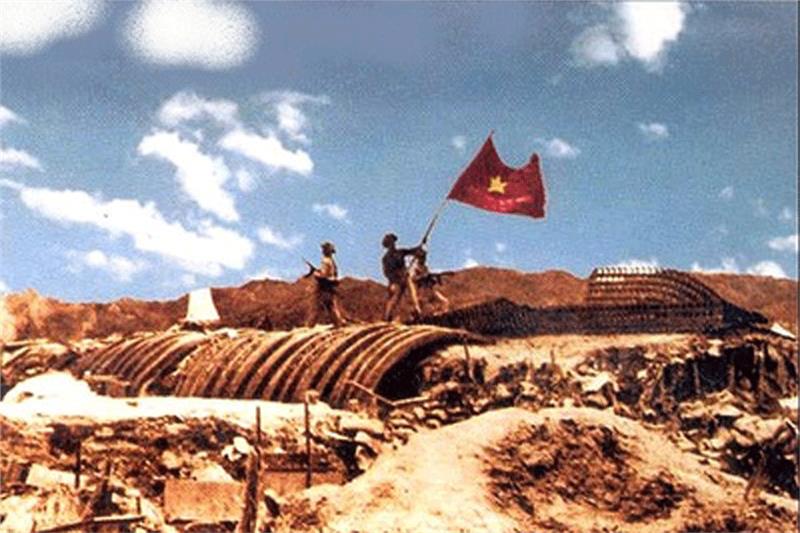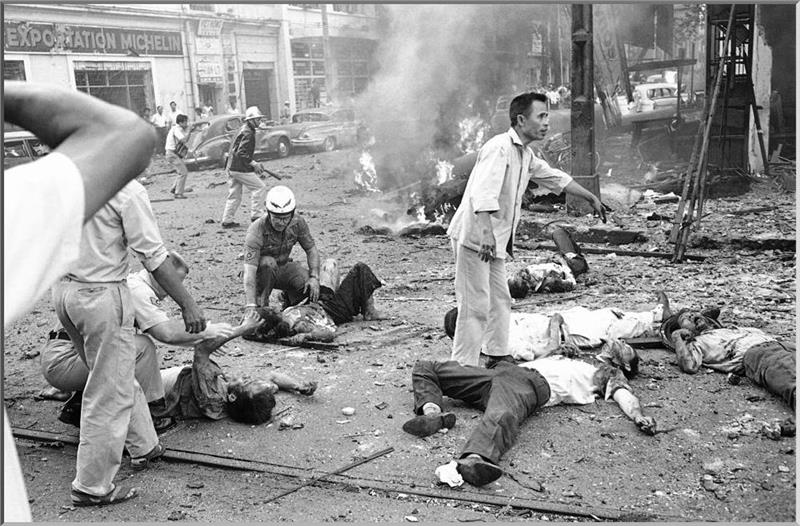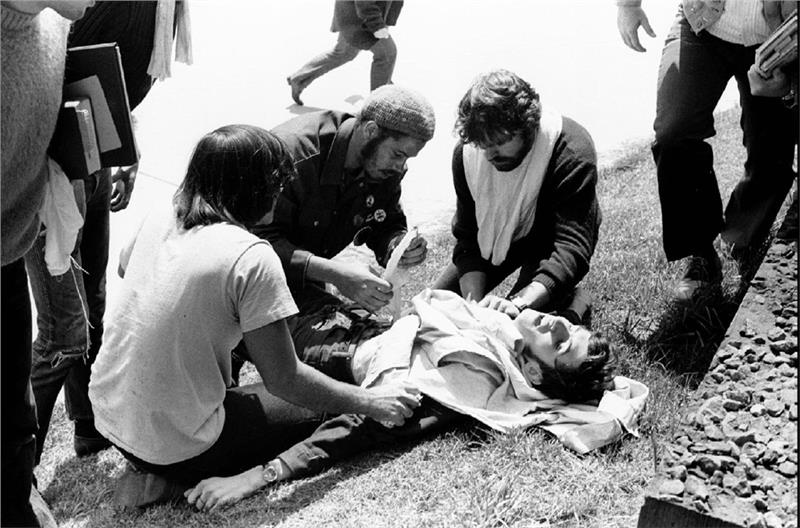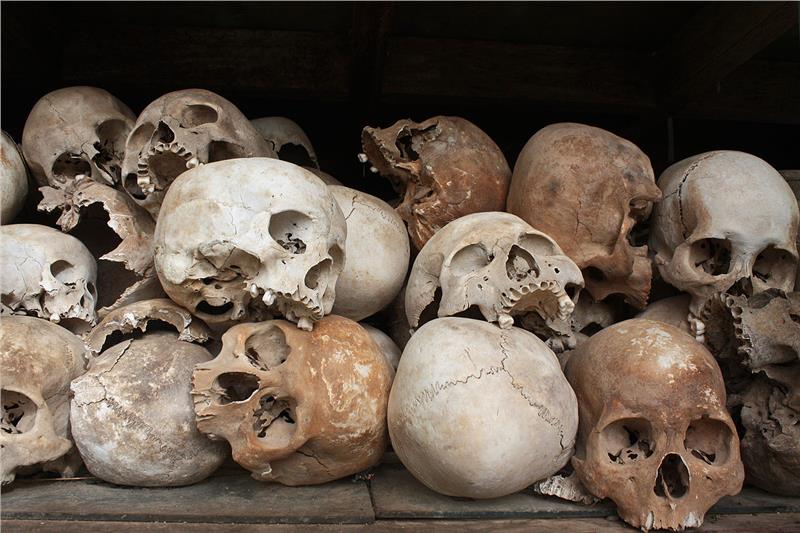Vietnam history from 1945 experienced a great amount of losses and pains. The victory of resistance against the French colonists and American intervention has a great historical meaning. It defeated wars of French invaders and American support, forced French to recognize the independence, sovereignty, and territorial integrity of Indochina. Northern Vietnam completely liberated, which enhanced physical and spiritual strength for revolution in Vietnam. The victory also supported more power for national liberation movement in the world, opening up the fall of the former colonial world, especially the colonial system of French.
The time-line of Vietnam history in this republican period is described as following.
After attacking Indochina in 1940 and negotiating with Vichy France (officially the French State), Japan had its real power of ruling Indochina. The government of French colonists in Vietnam ended in March 1945. Vietnam fell into an anarchy. Wars damaged Vietnam’s economy seriously. Having gained the power of ruling Indochina, Japanese set up a pro-Japanese government with the Bao Dai Emperor (the 13th as well as the last emperor of Nguyen Dynasty - the final Vietnamese monarchy). With the support and control of Japan, Bao Dai Emperor, Head of State, announced that according to the world situation in general and Asian situation in particular, Vietnamese government had cancelled, and disabled the Protectorate Treaty (often known as Patenôtre Treaty) signed between France and Annam (June 1884). The autonomy of an independent Empire of Vietnam was regained. At the same time, Tran Trong Kim (a renowned scholar) was selected to become the first Vietnamese Prime Minister. Despite of being a new nation as an empire, Vietnam was still controlled by Japanese. Vietnam again fell into the empire of Japan. Japanese seized rice and other products, forced Vietnamese people to destroy paddy fields and plant jute instead to serve the war. In addition, natural disasters and famine (Vietnamese Famine of 1945) occurred in Tonkin and Annam, worsening this situation. It is estimated that there are about two million people died from the famine. Not bearing the fact that the country was annexed by Japanese, Viet Minh with the leadership of Ho Chi Minh gained power in Northern and Central Vietnam, but failed in the South. On August 14, 1945, Japan surrendered to the Allies. While, in Southern Vietnam, Tran Trong Kim’s government lacked the support, could not control the situation, causing an anarchy in Vietnam. The power of France and Japan was erased, which created a gap in Vietnamese politics. The government of Vietnam Empire collapsed after over 5 months of existence, Bao Dai Emperor abdicated.

The most important historical highlight in this period is the birth of Declaration of Independence of the Democratic Republic of Vietnam which was made on September 2, 1945 in Ba Dinh Square, Hanoi Capital of Vietnam by Ho Chi Minh President. Vietnam unified from north to south. This declaration is a great milestone in the history of Vietnamese, and became an extremely important conversation in which 80-year French colonialism and thousand-year feudalism ended in Vietnam. According to the declaration, Vietnam was recognized as an independent nation with its own autonomy. It, also, expressed the highest determination of Vietnamese people in struggling for freedom, independence and happiness of people. In early 1946, a national election was held. Even though Vietnamese communists (Viet Cong) predominated, but other factions were also widely invited to join the government.
Only after two week was the independence of Vietnam threatened. In Northern Vietnam, Allies sent Chinese Army to disarm Japanese. Chinese Army occupied in the north of Vietnam until May 1946, and then transferred power to French government. Meanwhile, in Southern Vietnam, Japanese troops were disarmed by British Indian Army which handed power to France in 1945. During 1946, although Ho Chi Minh government negotiated with France in peace, armed forces were being prepared in both sides. As predicted, war between Viet Minh and French colonists broke out in December 1946.
In early 1947, France controlled all strategic footholds in Vietnam. However, Viet Minh kept applying “people’s war” strategy and guerrilla warfare generalship, organizing and training people to prepare for a long armed struggle. In 1949, to reduce burden of suppressing struggles in Vietnam, French colonists negotiated with some Vietnamese politicians who disagreed government of Democratic Republic of Vietnam led by Viet Minh to form a new state. Then, a treaty of establishing a new state, State of Vietnam, was signed between French colonists and Vietnamese politicians. The Head of State was Bao Dai. The government had the participation of old French officials. Armed force of Vietnam also joined French colonists to suppress Viet Minh. In 1950, Viet Minh was supported with weapons by Chinese and Russia, while French colonists received aid from America, especially cost of war. However, in early 1950s, French’s power became weak in Indochina, especially after its failure in Battle of Dien Bien Phu in May 1954, which ended all efforts of France and America in controlling Vietnam and Indochina. This catastrophic failure concluded the French invasion in Indochina. After that, Geneva Conference was held to negotiate and end the conflict between Vietnam and France. The Geneva Conference consists of exchanging prisoners, temporary separation of Vietnam with Ben Hai River (near the 17th parallel) as a border, allowing free flows passing the 17th parallel in 300 days. This division was expected to end when national elections could be held. According to the last statement of the conference, after two years of French soldiers withdrawing from Vietnam, a national election could be held to unify the country. People had a right to reside in the north or south of Vietnam. About one million of people who were Catholics and lived in Northern Vietnam migrated to the south.

The consequence of Viet Minh-France War is estimated that there is about over 35 thousand of military aircrafts killed, 48 thousand of wounded people; and there is no exact figure of Vietnamese casualties, but it surely is much higher than the above-mentioned numbers. Ho Chi Minh’s government regarded Geneva Conference as an important victory. It is because this convention required an election to establish a unified nation. They believed that they would win the election as the widespread reputation of Ho Chi Minh at that time. Yet, this election would never happen. After France withdrew, Eisenhower was the first president of America to go head first into Vietnam conflicts. He was announced that 80% of Vietnamese people would vote for Ho Chi Minh if the election happened. Eisenhower and his secretary of state John Foster Dulles believed that the Geneva Conference gave the communist too much power in the north. Thus, he decided to create the Southeast Asia Treaty Organization. The purpose of this treaty is to suppress communist influence in South Asia. He, also, started to build a separate regime in the south of the 17th parallel and let Ngo Dinh Diem be the leader. As the election did not take place, Democratic Republic of Vietnam resumed that this is an act of sabotaging Geneva Conference. At this time, Northern Vietnam entered the period when Ho Chi Minh government called on values of community towards socialism including collective farming. Most of Vietnamese people supported Ho Chi Minh authorities. However, there were some mistakes in Land Reform in 1950s, leading tens of thousands of wealthy landowners denounced, imprisoned, and killed. This triggered the chaos in northern social life.
In 1955, Ngo Dinh Diem won in South Vietnam’s Referendum, which allowed him to become the Vietnam’s Head of State, and the first President of Republic of Vietnam. Bao Dai went into exile to France. In Southern Vietnam, America gave Ngo Dinh Diem’s government a hand to build up a market economy, as well as improve the military to hold this government. In 1959, there were a few American living in Southern Vietnam. They were “consultants” under Ngo Dinh Diem’s government. However, the political turmoil in the late 1950s created great instability in Southern society. The Buddhist protests were oppressed, causing a profound religious conflict.
Since 1959, the government of Democratic Republic of Vietnam, Ho Chi Minh’s government, supported for Liberation Army of South Vietnam, or Viet Cong (a political organization and army in Southern Vietnam and Cambodia that fought the United States and South Vietnamese governments during the Vietnam War (1959–1975)). In early 1960s, the armed force of Viet Cong attacked widely in the countryside of South Vietnam, and bombarded in Saigon. America enhanced to support Republic of Vietnam by sending 17,500 “consultants”. However, because of serious conflicts between Ngo Dinh Diem’s regime and Vietnam’s Buddhism, along with the failure of South Vietnamese government against Viet Cong, Ngo Dinh Diem’s government was not supported by the United States. The General of Republic of Vietnam’s Army carried out a coup. Then, Ngo Dinh Diem was assassinated on November 1, 1963, which ended the first Republic of South Vietnam and established the foundation of Second Republic of South Vietnam. After these events, the United States vowed to continue supporting Republic of Vietnam in the military and economy.

On August 2 and 4 in 1964, Gulf of Tonkin Incident happened. They are two attacks of Vietnamese Navy under Vietnam People’s Army against two destroyers, USS Maddox and USS Turner Joy of the American Navy in Tonkin Gulf. The first Tonkin Gulf incident was confirmed by North Vietnamese Navy and American Navy. While, the second incident which was defined to be the mistake of America became an excuse for the opening of destroying Northern Vietnam by air force. On battlefield, Army of the Republic of Vietnam repeatedly failed in strategy of “special war” (special force operation). After that, Johnson, U.S President had an excuse to announce the Gulf of Tonkin Resolution, accordingly, American Armed Force was sent to Vietnam to participate in war. From March 1965, the armed force of America was sent to Vietnam in turn to work with about 20,000 “consultants” sent previously.
The number of U.S. combat troops reached its peak at about 540,000 soldiers. In 1964, war broke in Southern Vietnam and border areas between Vietnam, Cambodia and Laos. Meanwhile, the U.S. launched airstrikes in Northern Vietnam. There are two sides in this Vietnam War. In one side, it consisted of the Republic of Vietnam, the United States and allies of South Korea, Thailand, Australia, New Zealand, and the Philippines. In another side, the Democratic Republic of Vietnam along with the National Liberation Front for South Vietnam joined the war, while the Soviet Union and China provided military and advisory assistance. In 1967, Nguyen Van Thieu became the president of the Second Republic of South Vietnam. In the north, Le Duan was the leader of the Democratic Republic of Vietnam after the death of President Ho Chi Minh in 1969.
In early 1968, the Vietnam People's Army launched a Tet Offensive 1968 in most major cities in Southern Vietnam. There were about 1000 of American soldiers and 2000 of Army of the Republic of Vietnam troops killed, but the figures of Viet Cong were 10 times higher with about 32,000 deaths. In addition, in Khe Sanh battle occurring in the preceding week, nearly 500 American and 10,000 Vietnamese troops in the north had died. Despite of tactical failure, they made American government and people lose faith in the U.S. military’s victory in Vietnam. In November 1968, Johnson declared completely to stop “all air strikes, artillery and naval strikes in North Vietnam” and agreed to negotiate. However, one year later, President Richard Nixon, the successor of Johnson, came back Vietnam and continued Vietnam War. Nixon and his adviser, Henry Kissinger, gave birth to a strategy called “Vietnamization”. In June 1969, the National Liberation Front for South Vietnam announced the establishment of the Republic of Vietnam. Along with fighting in the battlefield, both sides were looking for solutions to end the war through talks in Paris. Until January 1973, Paris Peace Accords was signed between the United States, the Democratic Republic of Vietnam (in the north), and the Republic of Vietnam (in the south) after the crushing defeat of the U.S. in the air strikes in Ha Noi, Hai Phong and other northern cities in Vietnam by the U.S. Air Force conducted in late 1972.

In January 1974, China attacked and occupied Paracel Peninsula which was controlled by Republic of Vietnam at that time. After Paris Peace Accords in 1973, American troops withdrew from Vietnam. In this conference, Vietnam was announced to be independent and autonomic, and the U.S had to withdraw its armed force within 60 days. Despite of the accords, Vietnam War still occurred. With the withdraw of American troops and the American government’s cutting off aids for the Republic of Vietnam, Vietnam People’s Armed Force launched a revolt in Highlands in the middle of March 1975, opening the later campaigns. From Highlands, Hue to Da Nang, the footholds of American armed forces were occupied by Vietnamese armed force. On April 30, 1975, the Vietnam People's Army captured Saigon, the administration of President Duong Van Minh if the Republic of Vietnam surrendered. On April 25, 1976, Vietnam became an independent Vietnam nation called Socialist Republic of Vietnam without the national division. In 1977, Vietnam became the member of United Nations.
However, for both subjective and objective reasons as consistent policies in all aspects in accordance with northern standards (for example, plans to socialize the entire Southern economy to integrate with the economy in the North); continuous attacks by Khmer Rouge troops, natural disasters in 1977 and 1978 jeopardized the new nation. After Vietnam War ended, Vietnam and Cambodia appeared to be in conflict with each other. In May 1975, Khmer Rouge troops attacked Phu Quoc Island and Tho Chu of Vietnam. Between 1975 and 1978, conflicts and disputes worsened the Vietnam-Cambodia Relation. With the support of China, Khmer Rouge troops conducted many raids in Vietnam. It is estimated that there were about 30 thousand Vietnamese people and soldiers killed by Khmer Rouge troops in these attacks. In December 1978, Khmer troops mounted assaults in Vietnam-Cambodia border from Tay Ninh to Kien Giang, and Ha Tien Commune which were occupied by Khmer troops. Vietnam People’s Armed Force organized offensive against Khmer troops. On January 7, 1979, Vietnamese armed force attacked Phnom Penh. On January 8, with the support of Vietnam, Cambodia People's Revolutionary Party was established, led by Heng Samrin. After 10 days, the party signed a treaty with Vietnam to legitimize the Vietnamese military's presence in Cambodia. In 1989, Vietnamese armed force withdrew from Cambodia. The failure of Khmer Rouge in Cambodia and Vietnam was an excuse for China invaded Vietnam. On February 17, 1979, about a 300-thousand Chinese troop suddenly raided Northern Vietnam from Mong Cai to Lao Cai, but this occupation was suppressed by Vietnam. On March 18, 1979, China withdrew. Since then, Vietnam broke off relation with China. After 13 years, Vietnam-China relation was restored in 1992.

From 1945 to 1975, Vietnam thoroughly regained its independence and became an autonomous nation. The victory was the result of socialist revolution in the north, Vietnamese people and soldiers who wholeheartedly supported for the front-line South to defeat the U.S. invader. That victory was resulted from the unity of Vietnam, Laos, and Cambodia, along with the enthusiastic support of the labor movements and people around the world as well as the American people.
